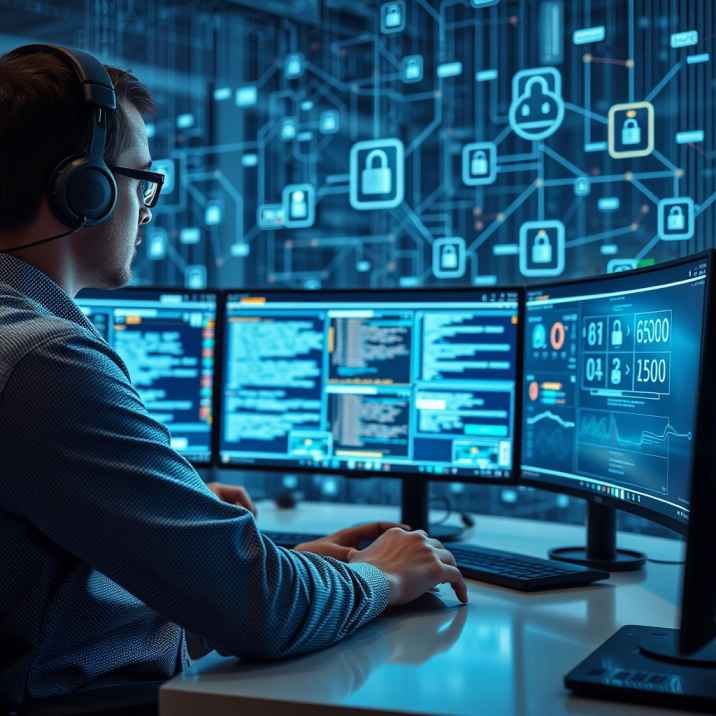
As technology evolves at an unprecedented pace, the importance of cybersecurity cannot be overstated. By 2025, cyber threats are expected to become more sophisticated, making it crucial for individuals and businesses to stay ahead.
Understanding the Growing Importance of Cybersecurity
Cybersecurity has transformed from a niche concern into a global priority. With cyberattacks costing businesses over $6 trillion annually by 2021, according to Cybersecurity Ventures , the stakes have never been higher. As we approach 2025, the need for robust security measures will only intensify.
Moreover, advancements in artificial intelligence (AI) and the Internet of Things (IoT) are creating new vulnerabilities. Consequently, understanding these risks is essential for safeguarding sensitive data.
Key Trends Shaping Cybersecurity in 2025
AI-Driven Cybersecurity Solutions
Artificial intelligence is revolutionizing how we detect and respond to threats. By analyzing vast amounts of data, AI systems can identify anomalies and predict potential attacks. This proactive approach is set to become a cornerstone of cybersecurity strategies by 2025.
Additionally, AI-powered tools will enable faster incident response times, minimizing damage caused by breaches. Companies like IBM Security are already investing heavily in this technology.
Quantum Computing and Encryption Challenges
It promises unbreakable encryption methods, it also threatens to render current cryptographic systems obsolete. Therefore, organizations must prepare for this shift by adopting quantum-resistant algorithms.
Zero Trust Architecture
Zero Trust is no longer optional; it’s becoming a necessity. This model assumes that no user or device should be trusted by default, even if they’re inside the network perimeter. As cybercriminals grow more innovative, Zero Trust ensures tighter control over access privileges.
Emerging Threats to Watch Out For
Ransomware Evolution
Ransomware attacks are expected to become more targeted and destructive by 2025. Attackers may exploit IoT devices, smart homes, and critical infrastructure, causing widespread disruption.
Furthermore, double extortion tactics—where attackers steal data before encrypting it—are likely to increase. Businesses must invest in advanced detection tools to mitigate these risks.
Deepfake Technology
Deepfakes, powered by AI, could be weaponized to spread misinformation or impersonate individuals. As these technologies become more accessible, their misuse poses significant ethical and security concerns.
Actionable Tips for Strengthening Cybersecurity
To protect yourself and your organization, consider implementing the following steps:
- Regularly update software, check compatibility and systems to patch vulnerabilities.
- Train employees on recognizing phishing attempts, save ownself with their training and social engineering tactics.
- Adopt multi-factor authentication (MFA) for all accounts.
- Partner with trusted providers offering cutting-edge solutions, such as Norton or McAfee .
By taking these precautions, you can significantly reduce your risk of falling victim to cybercrime.
Frequently Asked Questions About Cybersecurity in 2025
- What is the biggest cybersecurity threat in 2025?
Ransomware and AI-driven attacks are projected to dominate the threat landscape. - How will quantum computing impact cybersecurity?
It will enhance encryption but also render traditional methods vulnerable. - What is Zero Trust Architecture?
A security framework that eliminates implicit trust and verifies every user/device. - Can deepfakes be used maliciously?
Yes, they can manipulate public opinion or deceive individuals for financial gain. - Which industries face the highest risk?
Healthcare, finance, and government sectors are prime targets due to sensitive data. - Why is employee training important?
Human error remains one of the leading causes of successful cyberattacks. - Are small businesses at risk?
Absolutely; smaller firms often lack adequate defenses, making them easy targets. - What role does AI play in cybersecurity?
AI helps automate threat detection and response processes for greater efficiency. - How can I prepare for future threats?
Stay informed, adopt emerging technologies, and collaborate with experts. - Where can I learn more about cybersecurity trends?
Reputable sources include CSO Online and TechRepublic .
Final Thoughts
In conclusion, cybersecurity in 2025 will be shaped by rapid technological advancements and evolving threats. By embracing AI-driven solutions, adopting Zero Trust principles, and staying vigilant against emerging risks, you can secure your digital future.
For further information, Contact us OR Pentheblog .
